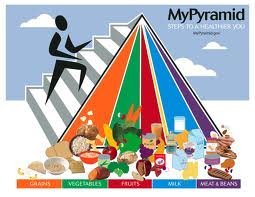MyPlate Replaces Food Pyramid
It's official--the food pyramid is history, and MyPlate is its new replacement. Finally, good nutrition is being taught with an easy-to-understand message. Make half of your plate fruits and vegetables (slightly more vegetables than fruits). Even if you are not eating on a plate, aim for eating 40% to 50% of your food as fruits and vegetables. This is good direction for a country where only one out of four Americans eats enough fruits and vegetables.
The meat group has finally been re-named the protein group, with an emphasis on leaner, low-fat types of protein as well as plant-based proteins such as beans, lentils and nuts. Beans and lentils are particularly healthy, and are counted in both the vegetable and protein groups.
The MyPlate guidelines recommend that at least half of the grains you eat be whole grains like high-fiber pasta, brown rice, whole-grain bread and quinoa. I recommend eating whole grains at least 80% of the time, and beans and lentils several times a week for optimal nutrition. Use white whole wheat flour or regular whole-wheat flour instead of white refined flour, and buy fewer processed foods (especially if made with white refined flour).
Low-fat dairy is included as well, shown as a side dish such as a glass of milk or a bowl of yogurt. Often it may be included in the meal, such as a caprese salad (tomatoes and fresh mozzarella). The plate idea is to show the proportion of the different food groups we should eat, as opposed to dictating numbers of servings and how the food groups should be laid out on the plate. A sandwich, for instance, will combine grains, meat, dairy and some of the vegetables together. Use lean meats, lower fat cheese and lots of vegetables on whole grain bread or in pita, with fruit and possibly a yogurt or milk on the side. A salad may contain all of the food groups.
In order to maintain a healthy weight through your life, it's critical to regulate the amount of food you eat by how hungry you are, not the amount of food on your plate. It is vital to stop eating when your body is feeling full. By this I mean not too full, just barely full, and encourage your children to do the same. Whatever is left over from the meal can be eaten later as a snack or even for the next meal. We all need to listen to our bodies' internal cues to decide how much to eat, rather than external cues like the time of day and amount of food put on our plate. Don't revert back to the old "eat everything on your plate " adage because you are following this new tool too literally. Use smaller plates if necessary, and skip the empty-calorie snacks and desserts, as well as soda and sugary drinks. Water or low-fat milk should be the beverage of choice. Using our internal cues to dictate the amount of food we eat, coupled with eating the right types of food as exemplified in the new MyPlate, can help us all live far healthier lives. Take my healthy challenge for August 2011 and have the whole family follow these new MyPlate guidelines:
Balancing Calories
Enjoy your food, but eat less.
Avoid oversized portions.
Foods to Increase
Make half of your plate fruits and vegetables.
Make at least half of your grains whole grains.
Switch to fat-free or low-fat (1%) milk.
Foods to Reduce
Compare sodium in foods like soup, bread, and frozen meals ― and choose the foods with lower numbers.
Drink water instead of sugary drinks.


